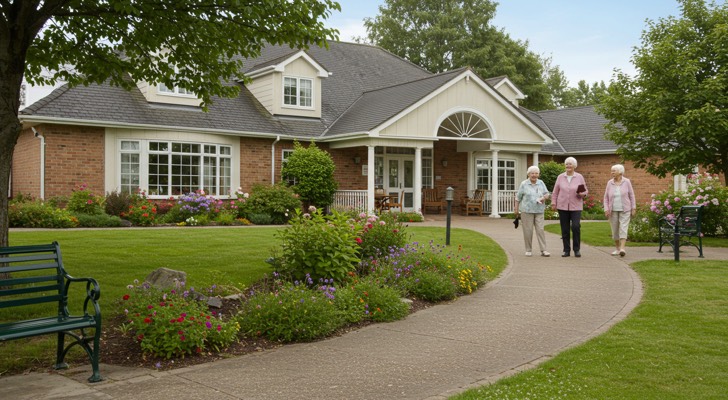As more seniors seek a comfortable and secure lifestyle in their golden years, retirement villages have become increasingly popular. These communities offer a blend of independence, social engagement, and healthcare support, making them an attractive option for older adults. However, understanding the costs associated with retirement villages is essential for making an informed decision.

What Are Retirement Villages?
Retirement villages are residential communities designed specifically for older adults, typically aged 55 and older. They offer a variety of housing options, including apartments, townhouses, and standalone homes. These villages provide amenities such as recreational facilities, dining services, healthcare support, and organized social activities, creating a safe and enjoyable environment for retirees.
Residents in retirement villages often have access to shared amenities such as clubhouses, swimming pools, fitness centers, and walking trails. Many communities also offer optional services, including housekeeping, transportation, and assistance with daily activities. This combination of independence and available support makes retirement villages appealing to seniors seeking a comfortable lifestyle with access to care if needed.
Cost of Living in Retirement Villages
The cost of living in a retirement village varies based on factors such as location, size of the property, amenities, and the level of care provided. Here are the main costs to consider:
- Entry Fee or Purchase Price: In some retirement villages, residents purchase their unit or home. The price ranges widely based on the location and size of the property. On average, purchasing a home in a retirement village can cost anywhere from $100,000 to over $500,000. In high-demand areas, prices may be significantly higher.
- Monthly Fees: Most retirement villages charge a monthly fee to cover the cost of maintenance, utilities, and access to shared amenities. These fees typically range from $1,500 to $4,000 per month, depending on the level of services provided.
- Service Fees and Add-Ons: Optional services, such as housekeeping, meal plans, and transportation, often come with additional charges. These can range from $200 to $1,000 or more per month, depending on the services selected.
- Healthcare and Assisted Living Costs: For seniors requiring healthcare or assisted living services, there may be additional costs. On-site care services, including medication management, personal care, and nursing support, can add $1,000 to $5,000 or more to monthly expenses, depending on the level of care needed.
Financial Considerations and Contracts
When considering a retirement village, it is important to understand the financial arrangements and contracts involved. Some villages operate on a leasehold or license agreement, meaning residents do not own the property but have the right to occupy it. Others involve a buy-in model, where residents purchase the property outright. It is essential to clarify whether the village offers a refundable deposit, deferred management fees, or exit fees upon leaving.
Deferred management fees are common in retirement villages. These are fees deducted from the sale price or entry fee when a resident leaves the village. They typically range from 20% to 30% of the original purchase price, reducing the final payout to the resident or their estate.
How to Find New Retirement Villages Near You
Finding a new retirement village near you requires thorough research and careful consideration. Online directories and websites, such as A Place for Mom, SeniorLiving.org, and Caring.com, offer comprehensive listings of retirement villages, allowing you to search by location, amenities, and cost. Real estate agents who specialize in senior housing can also help identify new or upcoming retirement villages in your area.
Local community resources, including senior centers and government offices, often have information on new retirement communities and their services. Additionally, social media platforms and forums, such as Facebook groups and Reddit communities, frequently feature recommendations and reviews from current residents and families, helping you find the most suitable options.
Benefits of Retirement Villages
Retirement villages offer several benefits, including a safe and socially engaging environment with access to healthcare services. The sense of community reduces isolation, and organized activities promote an active lifestyle. Villages also provide peace of mind by offering security and emergency response systems. For seniors seeking to downsize, these communities offer manageable, maintenance-free living.
Choosing the Right Retirement Village
To choose the right retirement village, consider factors such as location, amenities, and healthcare services. Visit multiple villages to compare costs, services, and the overall atmosphere. Review the contract carefully and seek legal or financial advice to understand the long-term financial implications. Consider the future needs for healthcare services and ensure the village can accommodate them.
Conclusion
Retirement villages provide a comfortable and secure living option for seniors, offering a blend of independence, social engagement, and care services. However, the costs can vary significantly, including entry fees, monthly charges, and potential healthcare expenses. Understanding the financial commitments, contract terms, and services provided is crucial for making an informed decision. By carefully evaluating the options and considering both current and future needs, seniors can find a retirement village that offers both comfort and financial peace of mind.
 © Copyright 2025 Shirabe-ru | Terms | Privacy Policy | Contact Us
© Copyright 2025 Shirabe-ru | Terms | Privacy Policy | Contact Us


